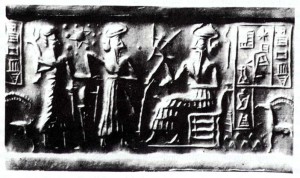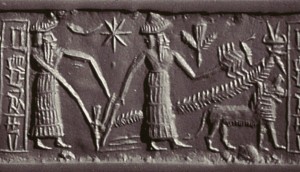The Electronic Text Corpus of Sumerian Literature
The Sumerian Farmer´s Instructions was inscribed about 1,700 BCE, thus predating Hesiod´s work by approximately a millennium. The piece is also known as The Instructions of Ninurta.
(Texts: All Artifacts, Color Coding, & Writings in Bold Type With Italics Inside Parenthesis, are Added by Editor R. Brown, not the Authors, Translators, or Publishers!)
(gods in blue)
1 Ud-ul-uru (Old man cultivator) gave advice to his son:
2-7 “When you have to prepare a field, inspect the levees, canals and mounds that have to be opened.
When you let the flood water into the field, this water should not rise too high in it.
At the time that the field emerges from the water, watch its area with standing water; it should be fenced.
Do not let cattle herds trample there.
8-13 After you cut the weeds and establish the limits of the field,
level it repeatedly with a thin hoe weighing two-thirds of a mina (approx. 650 g).
Let a flat hoe erase the oxen tracks, let the flied be swept clean.
A maul should flatten the furrow bottoms of the area.
A hoe should go round the four edges of the field.
Until the field is dry it should be smoothed out.
14-22 Your implements should be ready.
The parts of your yoke should be assembled.
Your new whip should hang from a nail —
the bindings of the handle of your old whip should be repaired by artisans.
The adze, drill and saw, your tools and your strength, should be in good order.
Let braided thongs, straps, leather wrappings and whips be attached securely.
Let your sowing basket be checked, and its sides made strong.
What you need for the field should be at hand.
Inspect your work carefully.
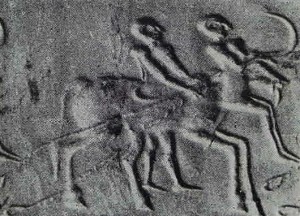 (earthlings learn to work for the gods in the fields)
(earthlings learn to work for the gods in the fields)
23-29 The plow oxen will have back-up oxen.
The attachments of ox to ox should be loose.
Each plow will have a back-up plow.
The assigned task for one plow is 180 iku (approx. 65 ha),
but if you build the implement at 144 iku (approx. 52 ha), the work will be pleasantly performed for you.
180 (?) sila of grain (approx. 180 liters) will be spent on each 18 iku area (approx. 6 1/2 ha).
30-34 After working one plow’s area with a bardil plow,
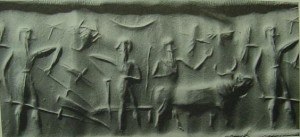 (earthlings & animal workers for the gods)
(earthlings & animal workers for the gods)
and after working the bardil plow’s area with a tugsig plow, till it with the tuggur plow.
Harrow once, twice, three times.
When you flatten the stubborn spots with a heavy maul,
the handle of your maul should be securely attached, otherwise it will not perform as needed.
35-40 When your field work becomes excessive, you should not neglect your work;
no one should have to tell anyone else: “Do your field work!”.
When the constellations in the sky are right, do not be reluctant to take the oxen force to the field many times.
The hoe should work everything.
41-45 When you have to work the field with the seeder-plow, your plow should be properly adjusted.
Put a leather sealing on the kacu of your plow.
Provide your beam with narrow pegs.
Your boards should be spread. Make your furrows.
46-54 Make eight furrows per ninda of width (approx. 6 m); the barley will lodge in more closely spaced furrows.
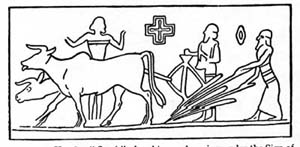 (knowledge learned from the alien gods)
(knowledge learned from the alien gods)
When you have to work the field with the seeder-plow, keep your eye on the man who drops the seed.
The grain should fall two fingers deep (approx. 3 1/2 cm).
You should put one gij of seed per ninda (approx. 3 ml/m).
If the barley seed is not being inserted into the hollow of the furrow, change the wedge of your plow share.
If the bindings become loose, tighten them.
55-63 Where you have made vertical furrows, make slanted furrows,
and where you have made slanted furrows, make vertical furrows.
Straight furrows will give you edges that are wide enough and nice (?).
Your crooked furrows should be straightened out.
Make the furrows clear.
Plow your portion of field.
The clods should be picked out.
The furrows should be made wide where the soil is open,
and the furrows should be narrower where the soil is clogged: it is good for the seedlings.
64-73 After the seedlings break open the ground, perform the rites against mice.
Turn away the beaks of small birds.
When the plants overflow the narrow bottoms of the furrows, water them with the water of the first seed.
When the plants resemble a …… reed mat, water them.
Water the plants when they are heading.
When the plants are fully leafed out, do not water them or they will become infected by leaf rust.
When the barley is right for husking, water it.
It will provide a yield increase of one sila per ban (approx. 1 liter in 10).
74-80 When you have to reap the barley, do not let the plants become overripe.
Harvest at the right time.
One man is to cut the barley, and one to tie the sheaves;
and one before him should apportion the sheaves: three men should harvest for you.
Do not let those who gather the barley bruise the grain.
They should not scatter the grain when it is in the stacks.
81-90 Your daily work starts at daybreak.
Gather your force of helpers and grain gatherers in sufficient number and lay down the sheaves.
Your work should be carefully done.
Although they have been having stale coarse flour,
do not let anyone thresh for your new bread — let the sheaves have a rest.
The rites for the sheaves should be performed daily.
When you transport your barley, your barley carriers should handle small amounts (?).
91-95 Mark the limits of a vacant lot of yours.
Establish properly your access paths to it.
Your wagons should be in working order.
Feed the wagon’s oxen. Your implements should be …….
96-103 Let your prepared threshing floor rest for a few days.
When you open the threshing floor, smooth its surface (?).
When you thresh, the teeth of your threshing sledge and its leather straps should be secured with bitumen.
When you make the oxen trample the grain, your threshers should be strong.
When your grain is spread on the ground, perform the rites of the grain not yet clean.
104-106 When you winnow, put an intelligent person as your second winnower.
Two people should work at moving the grain around.
107-109 When the grain is clean, lay it under the measuring stick.
Perform the rites in the evening and at night.
Release the grain at midday.
(giant mixed-breed shepherd, Ninurta, & plow given earthlings by Enlil)
110-111 Instructions of the god Ninurta, son of Enlil —
(alien giant Anunnaki did the burdensome work with much complaint, prior to fashioned earthling workers)
